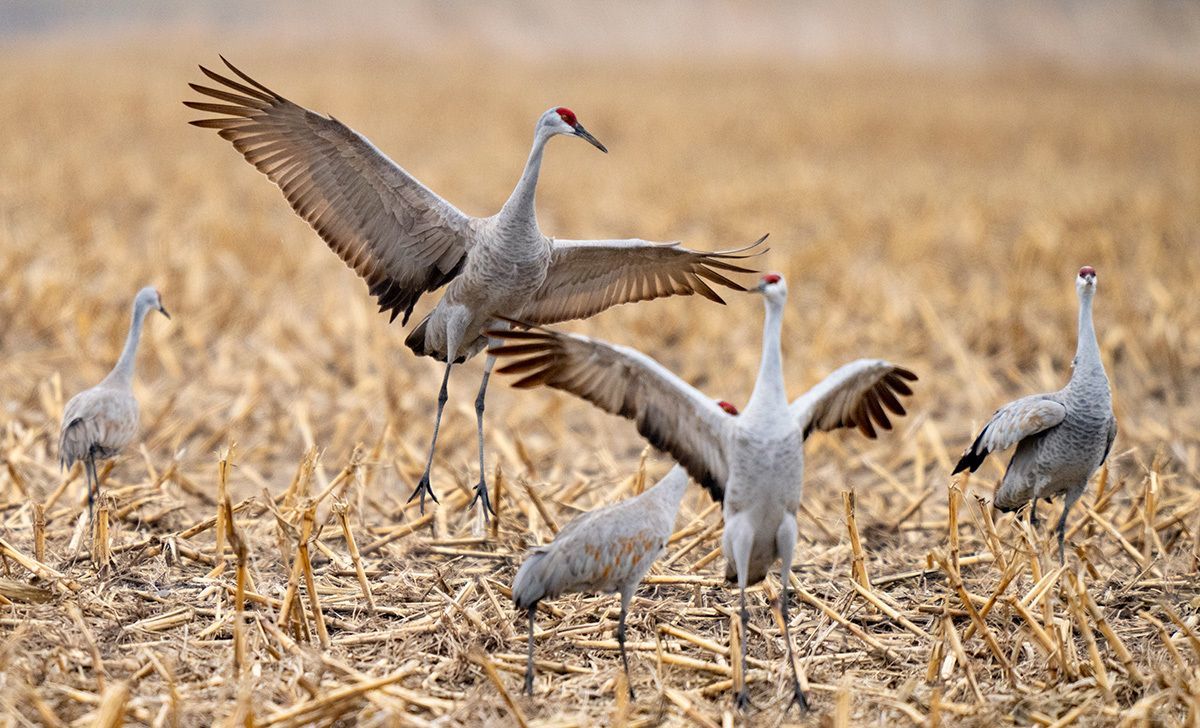
I was listening to Tristen Winder, host of KODY’s “Mugs in the Morning” radio show in the other day. He was talking with Lisa Burke, executive director of Visit North Platte.
Burke mentioned that she has already gotten a call from a potential tourist wanting to know if the sandhill cranes have begun to return, or when they might be here. I thought to myself, “yeah, it is probably about time to write something about the great grey birds.”
One thing I’ve learned about sandhill cranes is that you will most likely hear them long before you see them. The call of sandhill cranes can be heard at tremendous distances. To me it is sound that stirs the spirit.
Aldo Leopold, conservationist, forester and considered by some to be the father of wildlife ecology, once described the sounds of cranes like this, “High horns, low horns, silence, and finally a pandemonium of trumpets, rattles, croaks, and cries that almost shakes the bog with its nearness, but without yet disclosing whence it comes.”
Cranes make their unique calls through an amazing anatomical feature. Within the chest of sandhill cranes the trachea coils behind the sternum. The extra length of the trachea allows the voice of the crane to have its distinctive lower pitch and the harmonics that add richness to the tone. In the sandhill crane, the trachea enters the chest area and makes a couple of loops before it connects with the lungs.
What you see when you look at a crane is a long neck that may account for 15 to 20 inches of trachea and another 6-inches in the chest. But with the loops that the windpipe forms in the chest, it stretches out the total length to 50 inches or more. And remember, this 50-plus inch windpipe is in a bird that only stands four feet tall.
A trombone gets its lower tones by making the tube which the air passes through longer. The same thing is happening with the air in a crane and from that we get the low tones the birds make.
As far as when the birds return: Weather is the greatest determining factor for when the cranes arrive. Without severe winter weather, cranes have been known to arrive in Nebraska in early February.
Additional cranes appear each day as their numbers build to a peak around mid-March, unless a big winter storm pushes through the area.
Right now there are big winter storms moving across Texas that may be holding the birds in their southern habitats.
Weather also dictates how long the cranes will stay. If harsh weather lies between them and their nesting grounds in the Northwest Territories, Alaska and Siberia, the birds simply stay put, sometimes as late as May.
There are 15 species of cranes in the world. Two of these cranes are native to North America; the sandhill crane and the whooping crane. The sandhill crane is far more numerous. Some 600,000 will be passing through Nebraska in the next few weeks.
Whooping cranes can occasionally be seen traveling with sandhill flocks. Their white plumage makes them really stand out. A few will pass through Nebraska and eastern Colorado. Whooping crane numbers are perilously low. A violent storm in Florida a few years ago killed at least 17 birds and today there maybe as few as 800 in the world.
The migration of the cranes has taken place for millions of years. It is literally a world-class event that draws spectators to Nebraska from all around the globe.
It is often pointed out that the only other migration of this magnitude occurs on the Serengeti plains of Africa. The migration of wildebeests also brings the bulk of a single species together in one place on the globe.
Fossil records indicate that sandhill cranes have been part of Nebraska’s history for perhaps nine to 10 million years; far longer than the Platte River itself has been here.
Cranes come here for nourishment. They feast on invertebrates found in wet meadows and along the river. Protein from earthworms, snails and insects is critical for their nesting cycle.
They also make good use of grains left over from last year’s harvest. Corn is the energy source they store away for the long flight ahead of them. Cranes literally gather hundreds of tons of corn from the valley floor each spring. Birds can increase their total body weight by 20% or more during their brief stopover.
The birds often mate for life. Younger birds that are returning north for the first breeding season can be seen performing courtship dances in the fields.
Prospective mates approach one another, bob their heads and circle their partner. They leap into the air and flutter their wings, sometimes tossing bits of grass or sticks into the air. This display can go on for hours.
Some birds will roost on sandbars in the rivers each night. They appear to stand haphazardly in the channels in random patterns.
Actually they mark the edges of the sandbars by using every available square foot of the submerged islands. River roosts offer protection from predators. Deeper water around the sandbars acts as a moat, slowing down a hungry coyote or bobcat that might launch a sneak attack on roosting birds.
Contrary to what some folks say, not all cranes roost on the sandbars. Thousands of cranes gather at night in large meadows. As long as they have a wide buffer zone between themselves and places that could conceal a predator, the birds will rest.
Whether on the river or in open meadows, roosts are never completely quiet. All night long the birds murmur, shift and flutter uneasily.
A cloud passing between the earth and moon can send a shadow across roosting cranes and cause a stir within the flock. Purposely disturbing the birds on their roost should be avoided, because if they feel threatened they may abandon that spot permanently.
An estimated 150,000 or so of these great birds will settle into the land between the rivers just west of North Platte in the near future. It is a true sign of spring — they will be here.











